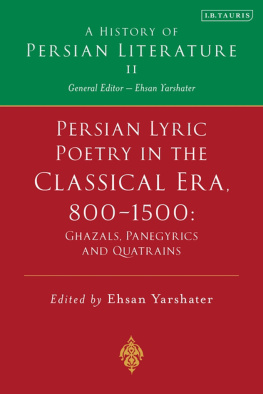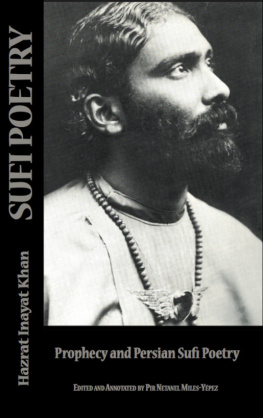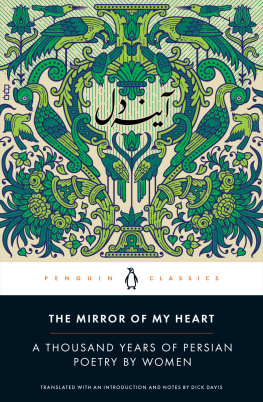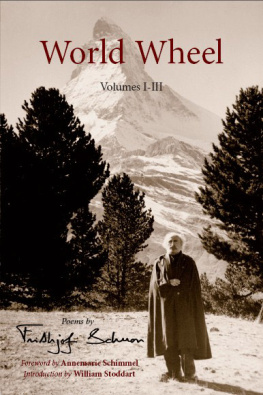Schimmel - A two-colored brocade: the imagery of Persian poetry
Here you can read online Schimmel - A two-colored brocade: the imagery of Persian poetry full text of the book (entire story) in english for free. Download pdf and epub, get meaning, cover and reviews about this ebook. City: United States, year: 2014;1992, publisher: The University of North Carolina Press, genre: Religion. Description of the work, (preface) as well as reviews are available. Best literature library LitArk.com created for fans of good reading and offers a wide selection of genres:
Romance novel
Science fiction
Adventure
Detective
Science
History
Home and family
Prose
Art
Politics
Computer
Non-fiction
Religion
Business
Children
Humor
Choose a favorite category and find really read worthwhile books. Enjoy immersion in the world of imagination, feel the emotions of the characters or learn something new for yourself, make an fascinating discovery.

A two-colored brocade: the imagery of Persian poetry: summary, description and annotation
We offer to read an annotation, description, summary or preface (depends on what the author of the book "A two-colored brocade: the imagery of Persian poetry" wrote himself). If you haven't found the necessary information about the book — write in the comments, we will try to find it.
Schimmel: author's other books
Who wrote A two-colored brocade: the imagery of Persian poetry? Find out the surname, the name of the author of the book and a list of all author's works by series.
A two-colored brocade: the imagery of Persian poetry — read online for free the complete book (whole text) full work
Below is the text of the book, divided by pages. System saving the place of the last page read, allows you to conveniently read the book "A two-colored brocade: the imagery of Persian poetry" online for free, without having to search again every time where you left off. Put a bookmark, and you can go to the page where you finished reading at any time.
Font size:
Interval:
Bookmark:
A Two-Colored Brocade

In the name of Him who has no name, and shows Himself at every name you call!
1992 The University of North Carolina Press
All rights reserved
Library of Congress Cataloging-in-Publication Data
Schimmel, Annemarie.
[Stern und Blume. English]
A two-colored brocade : the imagery of Persian poetry /
Annemarie Schimmel.
p. cm.
Enlarged translation of: Stern und Blume.
Includes bibliographical references and index.
ISBN 0-8078-2050-4 ( cloth : alk. paper)
ISBN 0-8078-5620-7 ( pbk. : alk. paper )
1. Persian poetryHistory and criticism. I. Title
PK6416.S3513 1992
891.551009dc20
92-2642
CIP
The publication of this book has been aided by the generous support of the Columbia Lecture Series on Iranian Studies that is intended to serve as a vehicle for the presentation of original research or synthesis in Iranian history and culture by distinguished scholars. This book is Volume 5 in the series.
The paper in this book meets the guidelines for permanence and durability of the Committee on Production Guidelines for Book Longevity of the Council on Library Resources.
Manufactured in the United States of America
cloth: 96 95 94 93 92 5 4 3 2 1
paper: 08 07 06 05 04 5 4 3 2 1
This book is based on the Authors Stern und Blume, published in 1984 by Otto Harrassowitz, Wiesbaden.
The calligraphic motifs at chapter openings are modern renditions from the pen of Dr. Shams Anwari-Alhosseyni, Lecturer in Persian, University of Cologne.
This book developed out of a lecture series which I have been giving at Harvard for more than twenty years. These lectures were meant, in the first place, to introduce students without knowledge of Persian into the colorful world of Persian and Persianate poetry, for the endowment of my chair specified as one of its main goals the study and translation of the poetry of Ghalib, the famous nineteenth-century poet of Delhi, who wrote in Persian and Urdu. As his extremely complicated style can barely be understood by anyone who lacks a thorough grounding not only in the aesthetics of Persian poetry as it developed over nearly a millennium but also in general Islamic culture, I found it necessary to offer at least a condensed introduction into this immense field of poetical language.
My lecture notes crystallized, in 1984, into a German book, Stern und Blume, which constitutes the basis for this enlarged version. The German title alludes to a line by the Romantic poet Clemens Brentano:
O Stern und Blume, Geist und Kleid,
Lust, Leid und Zeit und Ewigkeit.
O star and flower, spirit and garment,
Joy, sorrow, time, and eternity.
To me these lines seemed to reflect perfectly the constant interplay of the form (garment) and the spirit as well as the opalescent character of Persian poetry which so often allows the interpretation of a verse on two or even more levels.
This interplay of form and meaning has always fascinated me ever since I started translating some of Maulana Jalaluddin Rumis (120773) poems into German verse as a teenaged student. My interest in and love for Rumi has continued, and in fact increased, over the years, but other poets too have attracted me, especially Muhammad Iqbal (18771938), the modernist poet-philosopher of Indo-Pakistan. Later my fascination with Ghalib (17971869) led me into the history of earlier Urdu and Indo-Persian poetry. Beyond the highly sophisticated urban poetry of Iran, Muslim India, and Ottoman Turkey, however, I have enjoyed discovering poetry in the regional languages of Pakistan as well as popular Turkish poetry. Delighted listeners still hear the songs of Shah Abdul Laif (16891752) in Sind and the simple songs of the Turkish mystical bard Yunus Emre (d. ca. 1321) in Turkey, and I share their pleasure.
But my interest in the poetical language, the symbolism, the rhetorical aspects of Persian and, in a larger context, Islamic poetry has still another reason. When one translates specimens of this poetry poetically into ones mother tongue one realizes time and again how difficult it is for an untutored German- or English-speaking reader to understand the images, the numerous allusions to the Koran and to the heroes of classical Arabic and Persian history, and the role which language as language plays in this poetrya language that is elaborated as if the finest work of a goldsmith. On the other hand, the feelings expressed in this poetry are often measureless; love and unfulfilled longing, adulation and satire are expressed in metaphors and hyperbole that seem strange, if not absurd, to a sober modern reader.
To smooth the Western readers approach to this art I have thought it useful to collect whatever material seemed interesting to me: verses which I found simply delightful; others in which images appear that are not exactly compatible with modern taste; and, of course, many verses that seem to me typical expressions of this or that poetical interpretation of life and world. The thousands and thousands of notes I gleaned while reading poetry over the years have contributed to the growth of this book. Yet these are only minute droplets from an immense ocean, and every lover of Persian, Turkish, and Urdu poetry can immediately add other examples to augment the ones I offer here. For, as Mir Dard says:
How to describe the curls of the friend?
They are so long... and life is so short!
I am lucky in that I have always found friends with whom I could discuss poetry. Thus I came to know the neighborhoods of Istanbul through verses that classical and modern Turkish poets had composed about their beloved city, and my journeys through the deserts of Sind have been much enlivened by the recitation of poetry by my travel companions, as have been travels through the mountains of Afghanistan or long drives to the medieval Muslim cities in the Deccan. The same happened in the rose gardens of Shiraz and under the starry skies of Bangladesh. Poetry was in the air, was part and parcel of life, and a well-placed verse could enchant everyone, be it a member of the Pakistani government or an old illiterate woman in a Turkish village.
Because I have experienced Persian and Persianate poetry as a living force I have not attempted to construct literary theories but rather tried simply to show some of its peculiarities in the hope that the reader will learn to enjoy the variegated colors and forms of this art.
I have to apologize for two things. First, as the book was published first in German, the reader will find many references to Goethe, whose understanding of the spirit of Persian poetry was much superior to that of many learned scholars, and also references to Rckert, the ingenious orientalist-poet who, through his poetical translations from Arabic, Persian, Sanskrit, and many other languages, fulfilled in the German-speaking areas Herders dream of a world literature. English-language poetry does not have as strong a tradition of Persian influences and thus offers few cogent passages that might be more familiar to readers of the present edition. 1 hope they will be content, instead, with my translations from the German.
The second point is that only a few works of Persian, Turkish, or Urdu literary criticism are mentioned in the bibliography. But as the book is intended for the general reader who is not acquainted with these languages, I felt justified in offering only a small selection among them.
It is impossible to thank all those whose remarks have contributed to the growth of this book. Special gratitude, however, is due to William Chittick, who kindly read the whole manuscript in April 1990, and to Laura Oaks, gentlest of editors.
Next pageFont size:
Interval:
Bookmark:
Similar books «A two-colored brocade: the imagery of Persian poetry»
Look at similar books to A two-colored brocade: the imagery of Persian poetry. We have selected literature similar in name and meaning in the hope of providing readers with more options to find new, interesting, not yet read works.
Discussion, reviews of the book A two-colored brocade: the imagery of Persian poetry and just readers' own opinions. Leave your comments, write what you think about the work, its meaning or the main characters. Specify what exactly you liked and what you didn't like, and why you think so.





